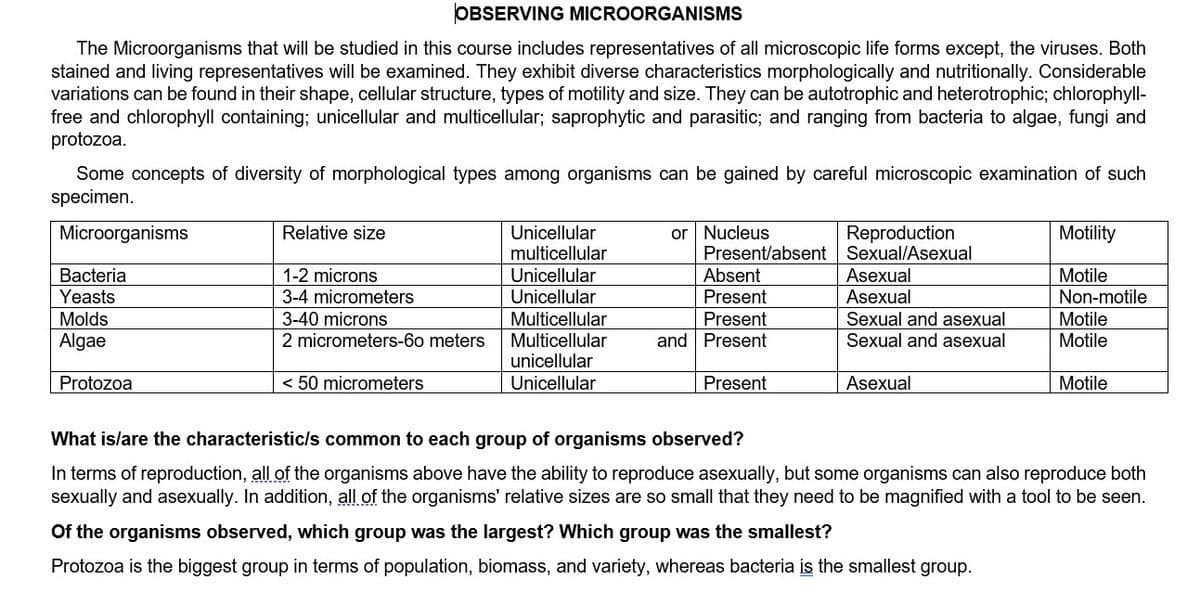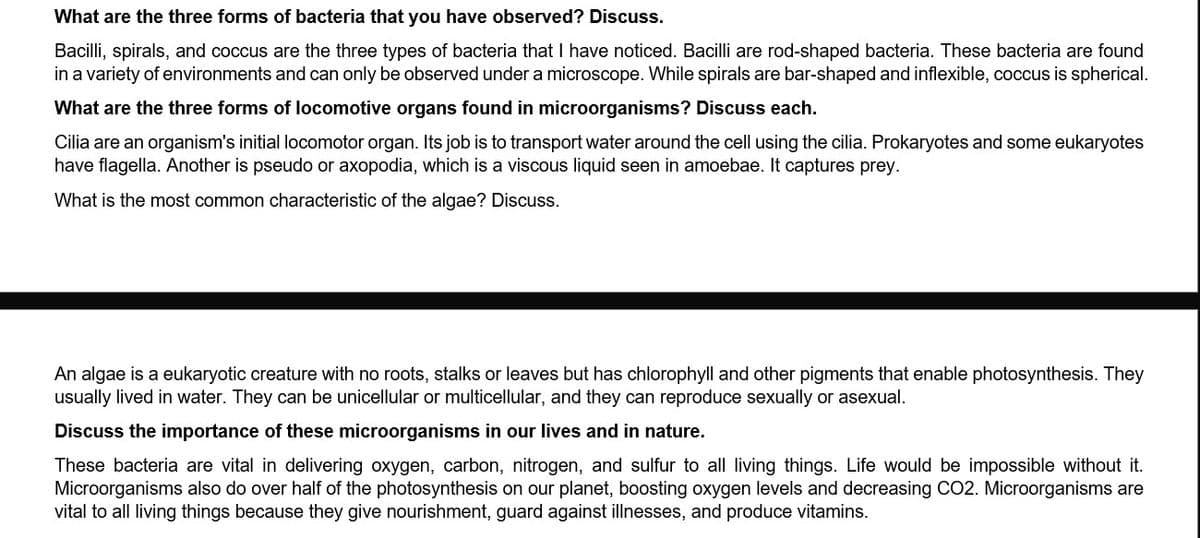Human Anatomy & Physiology (11th Edition)
11th Edition
ISBN:9780134580999
Author:Elaine N. Marieb, Katja N. Hoehn
Publisher:Elaine N. Marieb, Katja N. Hoehn
Chapter1: The Human Body: An Orientation
Section: Chapter Questions
Problem 1RQ: The correct sequence of levels forming the structural hierarchy is A. (a) organ, organ system,...
Related questions
Question
GIVE A CONCLUSION
OBSERVING MICROORGANISMS

Transcribed Image Text:OBSERVING MICROORGANISMS
The Microorganisms that will be studied in this course includes representatives of all microscopic life forms except, the viruses. Both
stained and living representatives will be examined. They exhibit diverse characteristics morphologically and nutritionally. Considerable
variations can be found in their shape, cellular structure, types of motility and size. They can be autotrophic and heterotrophic; chlorophyll-
free and chlorophyll containing; unicellular and multicellular; saprophytic and parasitic; and ranging from bacteria to algae, fungi and
protozoa.
Some concepts of diversity of morphological types among organisms can be gained by careful microscopic examination of such
specimen.
or Nucleus
Present/absent Sexual/Asexual
Microorganisms
Relative size
Unicellular
multicellular
Motility
Reproduction
Unicellular
Unicellular
Bacteria
1-2 microns
Absent
Asexual
Motile
Yeasts
Molds
3-4 micrometers
3-40 microns
2 micrometers-60 meters
Present
Asexual
Non-motile
Multicellular
Multicellular
unicellular
Present
Sexual and asexual
Motile
Algae
and Present
Sexual and asexual
Motile
Protozoa
< 50 micrometers
Unicellular
Present
Asexual
Motile
What islare the characteristic/s common to each group of organisms observed?
In terms of reproduction, all of the organisms above have the ability to reproduce asexually, but some organisms can also reproduce both
sexually and asexually. In addition, all of the organisms' relative sizes are so small that they need to be magnified with a tool to be seen.
Of the organisms observed, which group was the largest? Which group was the smallest?
Protozoa is the biggest group in terms of population, biomass, and variety, whereas bacteria is the smallest group.

Transcribed Image Text:What are the three forms of bacteria that you have observed? Discuss.
Bacilli, spirals, and coccus are the three types of bacteria that I have noticed. Bacilli are rod-shaped bacteria. These bacteria are found
in a variety of environments and can only be observed under a microscope. While spirals are bar-shaped and inflexible, coccus is spherical.
What are the three forms of locomotive organs found in microorganisms? Discuss each.
Cilia are an organism's initial locomotor organ. Its job is to transport water around the cell using the cilia. Prokaryotes and some eukaryotes
have flagella. Another is pseudo or axopodia, which is a viscous liquid seen in amoebae. It captures prey.
What is the most common characteristic of the algae? Discuss.
An algae is a eukaryotic creature with no roots, stalks or leaves but has chlorophyll and other pigments that enable photosynthesis. They
usually lived in water. They can be unicellular or multicellular, and they can reproduce sexually or asexual.
Discuss the importance of these microorganisms in our lives and in nature.
These bacteria are vital in delivering oxygen, carbon, nitrogen, and sulfur to all living things. Life would be impossible without it.
Microorganisms also do over half of the photosynthesis on our planet, boosting oxygen levels and decreasing CO2. Microorganisms are
vital to all living things because they give nourishment, guard against illnesses, and produce vitamins.
Expert Solution
This question has been solved!
Explore an expertly crafted, step-by-step solution for a thorough understanding of key concepts.
Step by step
Solved in 3 steps

Knowledge Booster
Learn more about
Need a deep-dive on the concept behind this application? Look no further. Learn more about this topic, biology and related others by exploring similar questions and additional content below.Recommended textbooks for you

Human Anatomy & Physiology (11th Edition)
Biology
ISBN:
9780134580999
Author:
Elaine N. Marieb, Katja N. Hoehn
Publisher:
PEARSON

Biology 2e
Biology
ISBN:
9781947172517
Author:
Matthew Douglas, Jung Choi, Mary Ann Clark
Publisher:
OpenStax

Anatomy & Physiology
Biology
ISBN:
9781259398629
Author:
McKinley, Michael P., O'loughlin, Valerie Dean, Bidle, Theresa Stouter
Publisher:
Mcgraw Hill Education,

Human Anatomy & Physiology (11th Edition)
Biology
ISBN:
9780134580999
Author:
Elaine N. Marieb, Katja N. Hoehn
Publisher:
PEARSON

Biology 2e
Biology
ISBN:
9781947172517
Author:
Matthew Douglas, Jung Choi, Mary Ann Clark
Publisher:
OpenStax

Anatomy & Physiology
Biology
ISBN:
9781259398629
Author:
McKinley, Michael P., O'loughlin, Valerie Dean, Bidle, Theresa Stouter
Publisher:
Mcgraw Hill Education,

Molecular Biology of the Cell (Sixth Edition)
Biology
ISBN:
9780815344322
Author:
Bruce Alberts, Alexander D. Johnson, Julian Lewis, David Morgan, Martin Raff, Keith Roberts, Peter Walter
Publisher:
W. W. Norton & Company

Laboratory Manual For Human Anatomy & Physiology
Biology
ISBN:
9781260159363
Author:
Martin, Terry R., Prentice-craver, Cynthia
Publisher:
McGraw-Hill Publishing Co.

Inquiry Into Life (16th Edition)
Biology
ISBN:
9781260231700
Author:
Sylvia S. Mader, Michael Windelspecht
Publisher:
McGraw Hill Education